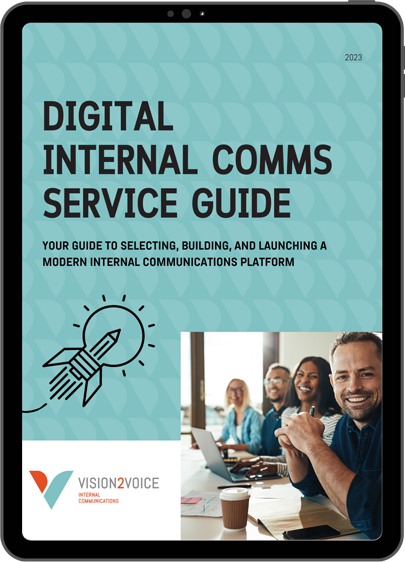“Customers will never love a company until the employees love it first.”
~ Simon Sinek
An organization’s brand is critical to its success. That’s probably why organizations spend about $674 billion yearly to build their brands. Yet the essential (and less expensive!) element of brand building is often overlooked – internal communication. The reality is that the most critical brand builders are your employees, and branding efforts that ignore their role in bringing your brand to life can be disastrous!
The power of a brand
Most of us instinctively understand the importance of a brand, but let’s quickly review why companies spend so much money on creating and sustaining one.
A brand gives your organization an advantage in the marketplace. It exerts a powerful emotional influence over people by promoting values or ideals that resonate with them. Apple and Disney are great examples of brands that connect to emotions deep inside us — Apple symbolizes innovation and creativity, and Disney represents the stories that sparked joy in our childhood.
A great brand builds trust and loyalty with a consistent and positive experience that brings people back again and again. An organization’s unique brand identity helps it stand out and position itself in the marketplace, increasing financial performance and value.
The critical role of employees in brand building
You can spend a fortune on marketing and brand building, but if your employees don’t understand your brand promise, aren’t equipped and empowered to deliver it, and aren’t connected to the brand on an emotional level, you won’t get very far. There will be a disconnect between the brand portrayed in your marketing and communications and the experience delivered. And there’s nothing worse than a brand that’s not authentic.
Luckily, connecting employees to your brand and helping them bring it to life is possible by following the seven steps we’ve mapped out for you. And when you harness the energy and passion of your employees, your brand will be powerful, authentic, consistent, and unstoppable!
Seven steps to building your brand from the inside
1. Start with an audit
An internal communication audit is a great start to identifying the disconnects between your internal communication strategy and your brand-building efforts. Most brands have guidelines that describe their values and qualities. These guidelines work with your brand identity (logo, font, colours) and your marketing and customer engagement strategy to create a strong, cohesive brand. In the audits we conduct for clients, we always look for gaps between the external marketing/communications that support your brand and internal communications.
In an audit we conducted for one of Canada’s most prominent universities, we found that employees needed help to connect their experience to the brand. The university had a clear brand-building framework and guidance from its marketing agency, but none of it was applied to internal communication. In another audit we conducted for a municipal government focused on improving service to residents, we found several gaps in their internal communication ecosystem that were a barrier to the city’s ability to improve service to residents—a key element of their brand promise.
2. Use a strategic approach
Building your brand from the inside must be critical to your internal communication strategy. Your strategy should map how you connect employees to your brand and include clear goals and success measures. It should be specific about what mindsets and behaviours employees need to bring the brand to life, and it should use an overarching narrative to link the organization’s purpose to the brand and what is expected from employees. Connecting these essential elements of your brand to the work employees do daily clarifies how they contribute to the organization’s success.
Take, for example, the city we mentioned in the step above. Their corporate strategy was to improve service for residents and businesses. To do that, they needed to equip employees with the tools and information they needed to provide better service. They also needed to create a service-oriented culture by reinforcing the mindsets and behaviours necessary to deliver outstanding service to the communities they serve. Another excellent example of a brand brought to life by employees is Starbucks (thank you, Pike Place, for keeping my eyes open long enough to finish this article!). In almost every location, you are greeted by employees with a smile and a kind word. I’ll never forget the summer I broke my wrist and how the baristas at my regular Starbucks went above and beyond to help me with my temporary disability. The actions of those employees have made me a loyal fan of the brand.
3. Harness leaders
Leaders are your culture carriers and the face of your brand. They are also critical internal voices and influencers inside your company. With this in mind, develop an executive internal communication strategy that provides clear guidance for leaders focused on bringing the brand to life for employees. This ensures consistent, authentic brand building inside and outside of the company.
When a leader turned to us to build more trust in his organization, he knew that building trust internally would also help build trust with the communities the organization served. We started by revamping the executive town hall to focus less on updates and more on trust building. Then, we created a supportive communication ecosystem concentrating on activating the values and behaviours necessary to develop a strategically aligned culture. This culture was the cornerstone of the brand the company was building, but it was only possible by activating leaders and ensuring executive communication supported the brand.
4. The medium is the message
At Vision2Voice, we think of internal communication channels as an ecosystem. The ecosystem needs to work in harmony to support your strategy. But the ecosystem itself also says a lot. As Marshall McLuhan argued, your ecosystem is not a passive information channel. Instead, it actively shapes and influences the fabric of your organization, affecting human perception and interaction in profound ways.
When you think about the channels in your organization, think about whether or not they are reinforcing your brand or detracting from it. If you are a tech company with antiquated internal communication platforms, what message is that sending? Similarly, what does it say if you run a retail outlet that sells upscale or luxury goods but have yet to invest in the capability necessary to reach your front-line employees?
With one of our clients, their intranet and omnichannel employee communication app is deliberately focused on telling the brand story. However, the fact that this innovative company leading the space industry uses a modern ecosystem sends a message about the kind of brand they are.
5. Tell stories
Storytelling is an excellent way of bringing your brand to life. Stories are not only more memorable but also more engaging and impactful. They do this by activating parts of our brains that are uniquely designed for stories. Stories also create a shared understanding of your company’s purpose, reinforcing the mindsets and behaviours required to activate the brand. And when it comes to humanizing your brand, nothing is better than stories that highlight the experiences and contributions of employees. This human connection can resonate deeply with both your employees and your customers.
Luxury retailer Nordstrom uses stories to help employees understand the level of customer experience they are expected to deliver. I’ve read about this in several business books. Still, I tested it one year and — sure enough, the sales associate at the accessories counter launched into a detailed account of one of the stories I had read about. The story’s details don’t matter (but if you must know, it was about a woman who lost a diamond and how cleaning and maintenance employees sifted through the contents of a vacuum cleaner to find it). Still, the fact that the story lives on and reinforces the brand Nordstrom is building confirms the power of storytelling!
6. Choose your words wisely
The words you use matter. Words and tone are fundamental in defining and communicating a brand’s identity. The language a brand uses helps create a distinct voice — and this is where our name comes from; it’s about helping organizations achieve their vision with a voice that captures the hearts and minds of employees (it’s also why our logo is in the shape of a heart).
It is critical to ensure consistency between your external and internal brand voices. If you are trying to build a friendly and approachable brand, but the tone of internal communication is robotic, stiff, and cold, you might need help.
One of our ongoing clients has an internal communication writing guide. It includes the things you’d regularly expect, such as the writing style, but it also includes a section on the brand voice. These guidelines for the company’s internal voice create consistency across all channels and ensure that every communication reinforces your brand. It’s a small but powerful step to building your brand from the inside.
7. Track progress
The last step in your journey of building your brand from the inside is to use metrics and insights to get a comprehensive view of how effectively your brand is being built. Setting goals and key metrics upfront- preferably as part of your strategy- is essential (see step 2). These can include data about alignment with company values and the brand from employee engagement surveys. It should also involve measuring things like innovation and patents (if your brand is about innovation), customer service data such as a net promoter score (if the focus of your brand is on exceptional service), or sustainability metrics (if being a sustainable brand is your goal).
Remember to use qualitative data, too! Employees are a great source of feedback and insight on whether or not their employee experience and the internal communication that supports it are aligned with brand strategies and communications.
Building your brand from the inside is more than making your employees brand ambassadors. It’s about ensuring that your internal and external communication strategies support each other and that every interaction, touchpoint, and communication creates an authentic, emotional, and meaningful connection with your brand.






